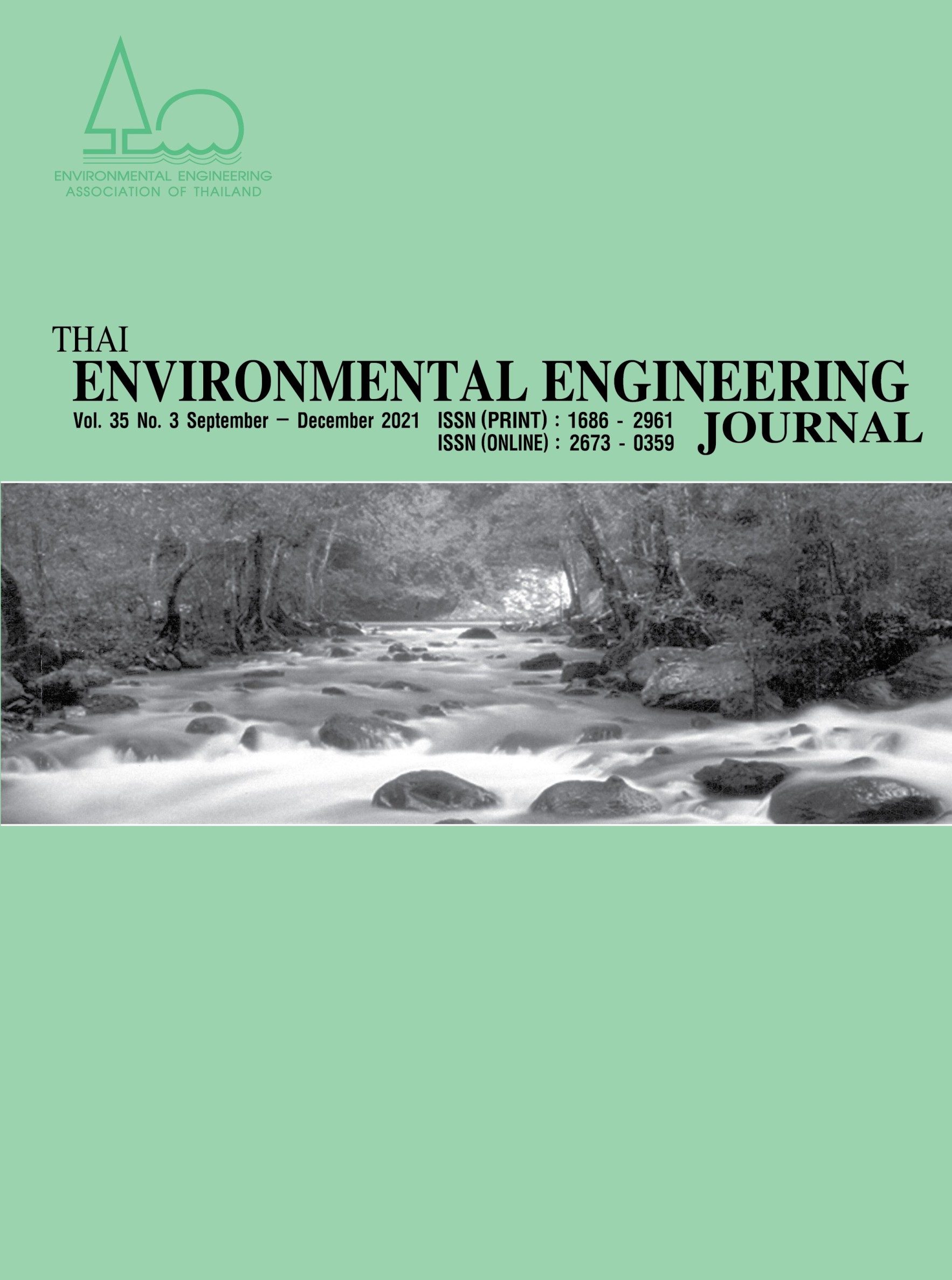Heat Management Options to Reduce Carbon Footprint of Green Zeolite Faujasite Synthesis from Rice Husk Ash
Main Article Content
Abstract
Zeolite could be derived from agricultural waste for green zeolite synthesis technology. It is one of the adsorbents that could reduce carbon dioxide emissions. This research was to develop a novel zeolite faujasite synthesis from rice husk ash as a silica source and to determine the carbon footprint with different heat management options including of crystallization temperature and time. The carbon footprint of zeolite faujasite was evaluated by quantifying the greenhouse gas emissions in terms of carbon dioxide equivalent using the framework of life cycle assessment methodology. The zeolite with 0.3 g was selected as the functional unit to evaluate the impacts of each condition from rice husk ash compared to conventional methods. The utilization of rice husk ash as a silica source instead of a chemical source could reduce the carbon footprint to 0.48 kgCO2eq, which is 8% less than the conventional one. The highest carbon footprint value was associated with the production stage under high temperature and longtime crystallization. The carbon footprint for successfully synthesized zeolite faujasite derived from rice husk ash with crystallization at room temperature and short time could be reduced by 48%.
Article Details
References
Lee, S.Y. and Park, S.J. 2015. A review on solid adsorbents for carbon dioxide capture. Journal of Industrial and Engineering Chemistry. 23: 1-11.
Chen, Y., Wang, B., Zhao, L., Dutta, P. and Winston Ho, W.S. 2015. New Pebax®/zeolite Y composite membranes for CO2 capture from flue gas. Journal of Membrane Science. 495: 415-423.
Kodasma, R., Fermoso, J. and Sanna, A. 2019. Li-LSX-zeolite evaluation for post-combustion CO2 capture. Chemical Engineering Journal. 358: 1351-1362.
Tobarameekul, P., Sangsuradet, S., Na Chat, N. and Worathanakul, P. 2020. Enhancement of CO2 Adsorption containing zinc-ion-exchanged zeolite NaA synthesized from rice husk ash [Online]. Available at: http://ojs.kmutnb.ac.th/index.php/ijst/article/view/3640 [Accessed on 29 July 2021].
Na chat, N., Maksiri, R., Vichaikham, P. and Worathanakul, P. Carbon footprint of zeolite A and zeolite Y derived from bagasse ash for CO2 Adsorption. At the 7th International Conference on Green and Sustainable Innovation, Bangkok, Thailand on October 17-19, 2018.
Worathanakul, P. and Rakpasert, N. 2016. Influence of different preparation methods of copper loading on Na-Y zeolite for green gas emission. International Journal of Environmental Science and Development. 7: 885-888.
Kongnoo, A., Tontisirin, S., Worathanakul, P. and Phalakornkule, C. 2017. Surface characteristics and CO2 adsorption capacities of acid-activated zeolite 13X prepared from palm oil mill fly ash. Fuel. 193: 385-394.
Worathanakul, P. and Saisuwansiri, P. 2017. Effect of copper and iron loading on zeolite Y for carbon dioxide adsorption. The Journal of King Mongkut's University of Technology North Bangkok. 28: 373-381.
Mohammed Ali, M.M., Ahmed, M.J. and Hameed, B.H. 2018. NaY zeolite from wheat (Triticum aestivum L.) straw ash used for the adsorption of tetracycline. Journal of Cleaner Production. 172: 602-608.
Prasara-A, J. and Gheewala, S.H. 2017. Sustainable utilization of rice husk ash from power plants: A review. Journal of Cleaner Production. 167: 1020-1028.
Belviso, C. 2018. State-of-the-art applications of fly ash from coal and biomass: A focus on zeolite synthesis processes and issues. Progress in Energy and Combustion Science. 65: 109-135.
Gui, F., Ren, S., Zhao, Y., Zhou, J., Xie, Z., Xu, C. and Zhu, F. 2019. Activity-based allocation and optimization for carbon footprint and cost in product lifecycle. Journal of Cleaner Production. 236: 117627.
Jradi, S., Chameeva, T.B., Delhomme, B. and Jaegler, A. 2018. Tracking carbon footprint in French vineyards: A DEA performance assessment. Journal of Cleaner Production. 192: 43-54.
Ledgard, S.F., Falconer, S.J., Abercrombie, R., Philip, G. and Hill, J.P. 2020. Temporal, spatial, and management variability in the carbon footprint of New Zealand milk. Journal of Dairy Science. 103: 1031-1046.
Percic, M., Ancic, I. and Vladimir, N. 2020. Life-cycle cost assessments of different power system configurations to reduce the carbon footprint in the Croatian short-sea shipping sector. Renewable and Sustainable Energy Reviews. 131: 110028.
Buslaev, G., Morenov, V., Konyaev, Y. and Kraslawski, A. 2021. Reduction of carbon footprint of the production and field transport of high-viscosity oils in the Arctic region. Chemical Engineering & Processing: Process Intensification. 159: 108189.
Thailand Greenhouse Gas Management Organization (TGO). 2020. Emission factor of product carbon footprint [Online]. Available at: http://thaicarbonlabel.tgo.or.th/admin/uploadfiles/emission/ts_117a1351b6.pdf [Accessed on 29 July 2021].
IPCC. 2013. Climate Change 2013: The Physical Science Basis. Cambridge University Press, Cambridge, United Kingdom.
Rakpasert, N. Preparation of different metals loading on FAU zeolite for NO reduction. Masters Degree, King Mongkut’s University of Technology North Bangkok, Bangkok, Thailand, 2012.


